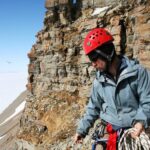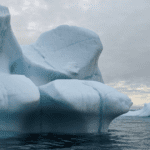With temperatures warming in the Arctic due to climate change, shrubby species such as birch, alder, and willow are expanding their range into open tundra—a shift referred to as “shrubification”.
It’s unclear what the overall effect of shrubification is on permafrost because shrubs can have opposing effects.
Branches protruding above the snow provide shade and trap blowing snow, better insulating the ground against melting. But shrubs also emit longwave radiation, which increases snowmelt.
A new study published in Arctic Science attempts to tease apart these competing factors with data collected at the northern edge of the boreal forest – tundra transition zone in the Northwest Territories.
Measuring the net effect of shrubs on permafrost can be complicated by their lack of uniformity across the Arctic landscape, so the authors took measurements in four areas that differed in shrub type: shrub-free open tundra, dwarf birch patches 40–60 cm high, alder patches 80–150 cm high, and stream channels with 150–250 cm alder and willow shrubs.
They recorded the depth of the frost table—the point at which the ground is frozen—taking more than 3000 measurements over the course of four months to determine the extent of soil thawing in the summer.
The authors found that the date that an area became snow-free in spring was a major indicator of the depth of thawing that would take place that summer; certain shrubs had a greater effect on this date than others.
Among the studied areas, the shorter birch shrubs that protrude, but are too short to trap snow, had the greatest effect in causing earlier snow-free dates.
What’s more, even those shrubs tall enough to trap blowing snow will eventually be limited by the amount of available snow and begin to contribute to greater thawing as well.
“It’s a tricky topic to explain because of all of these counter-acting effects,” says lead author Evan Wilcox, a PhD student at Wilfrid Laurier University’s Cold Regions Research Centre.
“Shrubs that protrude through the snow at the end of winter cause snow to melt faster in spring, which allows soil to begin thawing earlier in spring and leads to deeper soil thaw by the end of summer,” he explains.
Wilcox adds that “the main mechanism by which shrubs lead to earlier snow free dates is just by protruding through the snow. This effect is maximized when the shrubs are tall enough to protrude through the snow but not tall enough to trap additional snow.”
The authors expect the conditions that lead to increased thawing will become more prevalent given trends of decreasing snow depths and increasing shrub height and areal extent in the Arctic.
“There are likely areas of the Arctic where shrubs are not tall enough to protrude through the snowpack yet, but may begin doing so in the future,” he says.
Read the open access paper: Tundra shrub expansion may amplify permafrost thaw by advancing snowmelt timing in Arctic Science.




